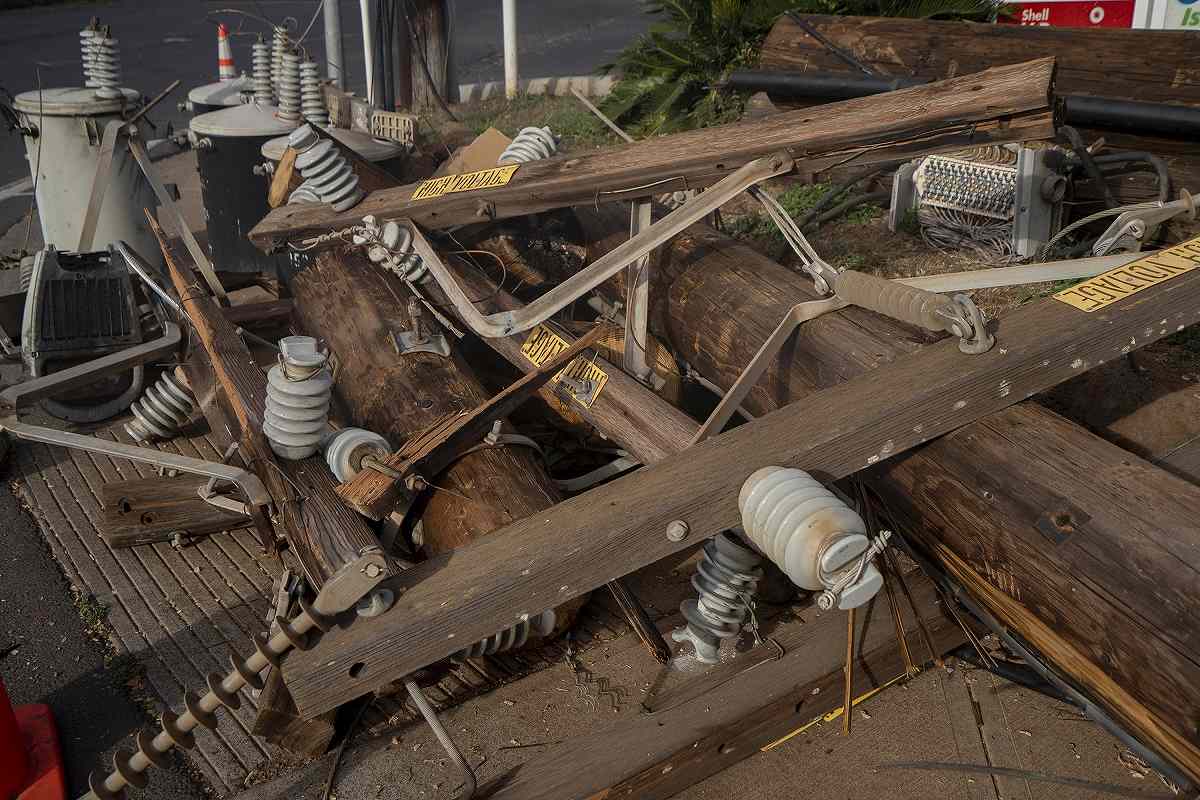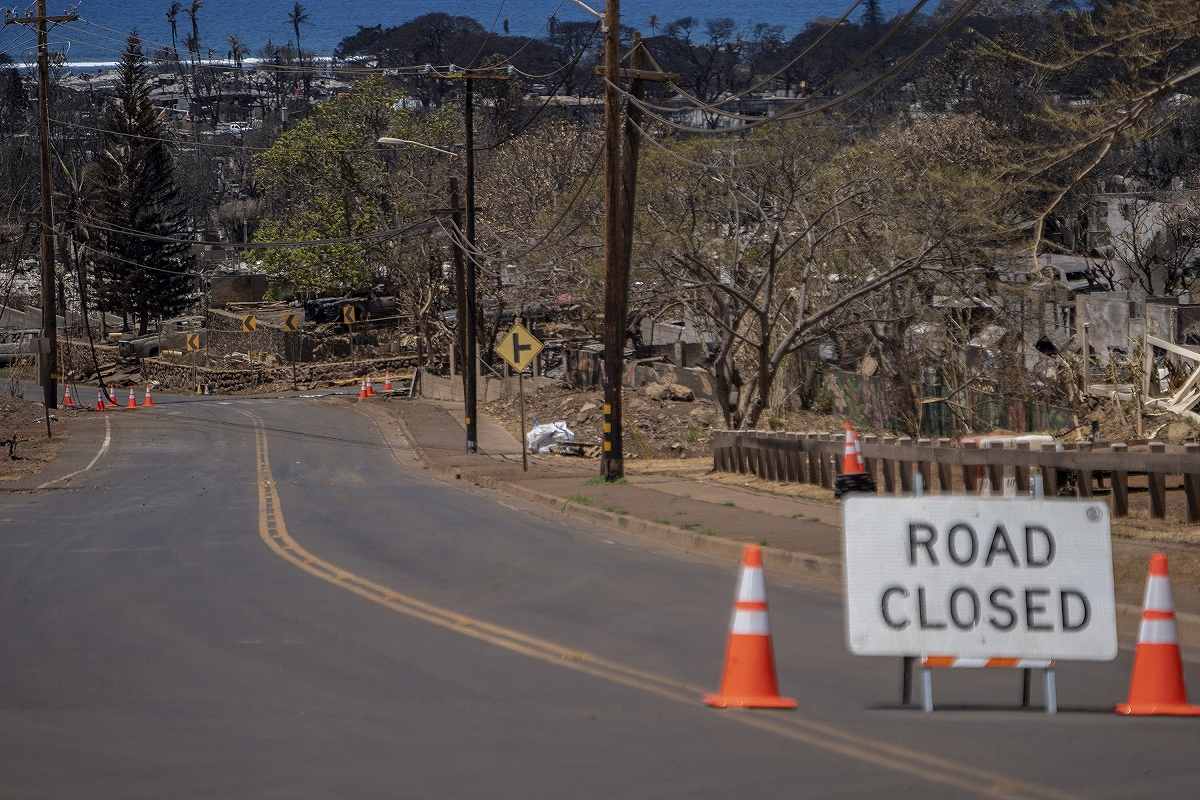
Fallen utilities poles outside of a gas station on Lahainaluna Road in Lahaina, Hawaii, on Aug. 21.
15:44 JST, August 26, 2023
LAHAINA, Hawaii – The Hawaii power utility believed to have started the deadly Lahaina fire removed damaged power poles and other equipment from a key fire scene, potentially affecting evidence that is part of an official investigation into how the blaze ignited.
Hawaiian Electric – which acted quickly to restore power on the island after Aug. 8 – hauled away fallen poles, power lines, transformers, conductors and other equipment from near a Lahaina substation starting around Aug. 12, documents show, before investigators from the federal Bureau of Alcohol, Tobacco, Firearms and Explosives (ATF) arrived on scene.
Those actions may have violated national guidelines on how utilities should handle and preserve evidence after a wildfire and deprives investigators the opportunity to view any poles or downed lines in an undisturbed condition before or after the fire started, according to court documents, letters and other records obtained by The Washington Post.
“If a lot of equipment is already moved or gone by the time investigators show up, that’s problematic because you want to observe where the equipment was relative to the ignition site,” said Michael Wara, who directs the Climate and Energy Policy Program at Stanford University. “Maybe there was a homeless encampment, kids, or a power line down on the ground where the ignition occurred. But once you move these things it’s much harder to understand what happened.”
In a statement, Hawaiian Electric spokesman Darren Pai said the company has been “in regular communication with ATF and local authorities and are cooperating to provide them, as well as attorneys representing people affected by the wildfires, with inventories and access to the removed equipment, which we have carefully photographed, documented and stored.”
ATF usually responds to bombings and shootings. This is only the agency’s third wild-land fire investigation, a spokesperson said. Usually, the U.S. Forest Service serves in this role, but since the Maui fires were not on any national forest lands, ATF has become the primary federal investigative force.
While the causes of the fires in Lahaina – as well as others in the Upcountry region of Maui – are still under investigation, there is mounting evidence that Hawaiian Electric’s wind-damaged equipment sent sparks into the dry, overgrown vegetation surrounding its poles.
As The Post first reported, the utility did not shut off power in advance of high winds, though it said it took some other preemptive measures. Now, it is facing at least nine lawsuits for its role in allegedly sparking the Maui wildfires, including the one that destroyed Lahaina and killed at least 115 people in the nation’s most deadly blaze in a century.
One of those was filed Thursday by Maui County, which is suing the utility for “inexcusably” not shutting off power despite being warned that high winds were coming, and not maintaining equipment and surrounding vegetation to “properly ensure that they would not cause a fire.”
ATF investigators arrived on the island last week to help with “determining the origin and cause of the wildfires there.” But by then, utility crews had cleared much of the site near the substation off Lahainaluna Road and moved damaged equipment to a warehouse.
Hawaii, unlike California, does not have a state fire agency such as Cal Fire that immediately deploys investigators to fire scenes to ensure evidence is preserved. Such investigators help to preserve important details at a fire scene, such as flash marks on conductors, or globs of aluminum or copper that might have melted and fallen into the brush below, experts said.
Starting Aug. 10, a law firm representing more than two dozen Lahaina families asked Hawaiian Electric two times to preserve evidence, according to correspondence obtained by The Post. The next day, one of the utility’s attorneys replied that Hawaiian Electric’s main focus was the safety of first responders actively fighting the fires, displaced residents and restoring power.
The company said it was “taking reasonable steps to preserve its own property.” However, because so many local, state and federal agencies were on the ground to fight the fires and clear debris, it was “therefore possible, even likely, that the actions of these third parties, whose actions Hawaiian Electric does not control, may result in the loss of property or other items that relate to the cause of the fire.
“Hawaiian Electric will take reasonable steps to preserve evidence but cannot make any guarantees due to the rapidly evolving situation on the ground, which also is not within our control,” the letter said.
In response, attorneys quickly submitted a temporary restraining order to stop Hawaiian Electric from greatly altering the scene where it’s believed the first fire in Lahaina started, court documents show.
On Aug. 18, a judge signed an interim discovery order, which detailed how the utility should handle evidence around the “suspected area of origin.”
There is a process for how utilities should handle the site where it is believed a fire started. The National Fire Protection Association states that “the integrity of the fire scene needs to be preserved. . . . Evidence should not be handled or removed without documentation” and the scene cordoned off with tape or flags.
Hawaii’s Public Utilities Commission, which oversees Hawaiian Electric, has yet to comment on the fires. It also did not respond to multiple requests for comment over the last two weeks on whether, through its investigative arm, the commission is conducting a probe into what might have caused them.
“The commission has been completely silent on this whole event which is terribly frustrating,” said Jennie Potter, a former utilities commissioner who retired nine months ago.
In court documents and letters from a Hawaiian Electric, the utility said it removed the equipment because the company does not “own or control the land or public streets beneath its facilities in this area.
By Aug. 12, the utility had retained Munger Tolles & Olson – the same law firm that represented Pacific Gas & Electric, the beleaguered California utility found responsible for starting the deadly 2018 Camp Fire.
To “preserve potential evidence related to the fire,” the utility said, it hired a California-based “cause and origin expert” – which also helped PG&E on several Northern California fires – that has been handling the removal of equipment to a warehouse.
Many experts and financial analysts have been comparing Hawaiian Electric’s case with that of PG&E, California’s largest utility and one of the United States’ largest investor-owned electric utilities. It filed for bankruptcy in 2019, facing billions of dollars in liability claims for the Camp Fire and other deadly wildfires.
California utility officials had also fined PG&E and SoCal Edison for altering or not properly preserving evidence after a fire before investigators arrived.
PG&E is not the only utility that has faced legal troubles for removing evidence from a fire scene. After a disastrous spate of fires in Oregon in 2020, a class-action lawsuit was filed against PacifiCorp for the blazes. The case focused on the utility’s destruction of evidence, said Timothy DeJong, an attorney for the plaintiffs. In June, a jury found the utility had played a significant role in starting those blazes and owed plaintiffs $73 million.
“The experts had no chance to review the physical evidence,” said DeJong. “As a result, much of the evidence about causation came from eyewitnesses who saw power lines arcing and sparking or starting fires.”
Hawaiian Electric was familiar with PG&E’s troubles, filings show. Last summer, it noted that utility companies can be held liable when it comes to sparking or spreading a wildfire, and cited PG&E’s “$15 billion settlement” with victims as an example. “The risk of a utility system causing a wildfire ignition is significant,” the company wrote.
Residents who live near where the fire started say that the power company reacted quickly. By the time Ryan Gazmen returned to his home off Lahainaluna Road on Aug. 11, he said a nearby broken pole whose top had snapped off had been fixed.
The afternoon of Aug. 12, a Post reporter visited the area where residents say and videos show the initial fire ignited. In a dirt alleyway across from the Hawaiian Electric substation, there was a damaged pole lying on the ground, the top of it haphazardly sitting in some nearby trees, with lines coiled up and pieces of a pole stacked around it. Experts who examined the photo questioned why the material was left there without tags or being taped off from the public. About a week later, that equipment was gone.
In comparison, within hours of the Camp Fire igniting, CalFire arson investigators arrived at PG&E’s transmission towers where they suspected the blaze ignited and assessed the ground, noticing the fire’s burned path, according to a report from the Butte County district attorney. “Looking up, the investigators saw a detached line hanging down into the steel superstructure of the high-voltage transmission tower,” the report said. They immediately launched an investigation.
In a news conference last week, Hawaiian Electric CEO Shelee Kimura said that 400 out of West Maui’s 750 poles were damaged or destroyed in the wind storm and fires, and 300 out of 575 transformers were visibly damaged. The substation off Lahainaluna Road was destroyed.
Data from Whisker Labs, a company that uses an advanced sensor network to monitor grids across the United States, found numerous incidents in the power grid late on Aug. 7, knocking out power. The power came back on at 6:10 a.m. the next day, the data shows, and then went back off again at 6:39 a.m. It was during that time that a fire sparked in the grass by the Lahainaluna substation, according to residents and the Maui Fire Department.
A spokesperson for Maui Fire Department said that crews had contained and “cleared” the blaze around 12:45 p.m. Engines left at 12:47 p.m., which was “an appropriate amount of time,” he said, and there were two other fires burning on the island demanding their attention.
At 2:55 p.m., several residents all recalled smelling smoke, and two called 911. The Maui Fire Department confirmed those calls and said an engine in the area was on the scene within five minutes. At first, firefighters had the blaze in check, but a gust of wind sent flames down the hill in front of them.
That was the blaze that tore into downtown Lahaina, resulting in Hawaii’s most destructive and deadly fire ever.

A road closure sign blocks Lahainaluna Road in Lahaina, Hawaii, on Aug. 20.
"News Services" POPULAR ARTICLE
-

American Playwright Jeremy O. Harris Arrested in Japan on Alleged Drug Smuggling
-

Japan’s Nikkei Stock Average as JGB Yields, Yen Rise on Rate-Hike Bets
-

Japan’s Nikkei Stock Average Licks Wounds after Selloff Sparked by BOJ Hike Bets (UPDATE 1)
-

Japanese Bond Yields Zoom, Stocks Slide as Rate Hike Looms
-

Japan’s Nikkei Stock Average Buoyed by Stable Yen; SoftBank’s Slide Caps Gains (UPDATE 1)
JN ACCESS RANKING
-

Keidanren Chairman Yoshinobu Tsutsui Visits Kashiwazaki-Kariwa Nuclear Power Plant; Inspects New Emergency Safety System
-

Imports of Rare Earths from China Facing Delays, May Be Caused by Deterioration of Japan-China Relations
-

University of Tokyo Professor Discusses Japanese Economic Security in Interview Ahead of Forum
-

Japan Pulls out of Vietnam Nuclear Project, Complicating Hanoi’s Power Plans
-

Govt Aims to Expand NISA Program Lineup, Abolish Age Restriction





















